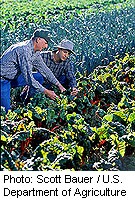
THURSDAY, March 28 (HealthDay News) — The types of harmless bacteria on the surfaces of fresh fruits and vegetables vary according to the type of produce and farming practices, a new study reveals.
Previous research has shown that these so-called “non-pathogenic” bacteria don’t cause disease, but may interact with — and perhaps reduce the growth of — disease-causing bacteria.
For the new study, published online March 27 in the journal PLoS One, researchers Jonathan Leff and Noah Fierer of the University of Colorado, Boulder, looked at 11 types of fruits and vegetables that are often eaten raw.
The study authors found that certain fruits and vegetables — such as spinach, tomatoes and strawberries — have similar surface bacteria and that most of these bacteria belong to one family.
Other fruits — including apples, peaches and grapes — have more variety in the types of surface bacteria, belonging to three or four different groups, according to the study.
The investigators also found that surface bacteria found on fruits and vegetables varied depending on farming practices.
Several factors may contribute to the differences in surface bacteria found on fruits and vegetables, including farm locations, transport conditions and storage temperature or time, the authors said in a news release from the Public Library of Science.
They noted that these surface bacteria can affect the rate at which food spoils, and may be the source of typical bacteria on kitchen surfaces.
More information
The U.S. Food and Drug Administration has more about safely selecting and serving raw produce.

